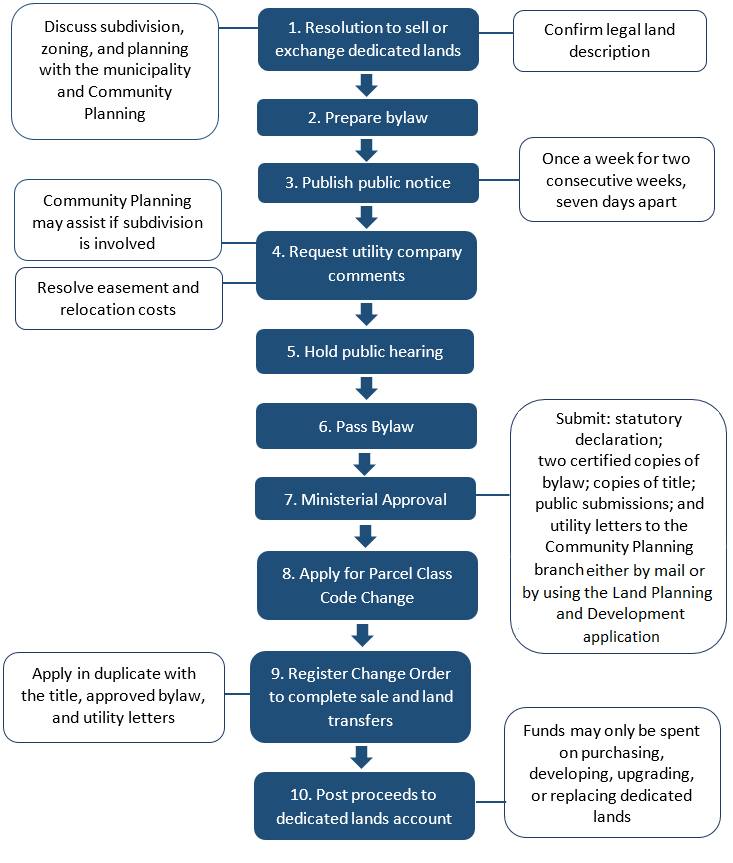Overview
Municipal reserve lands are used for recreation and leisure, and may include public parks and community buildings. Lands dedicated as municipal reserve become the property of the municipality in which they are located, and their maintenance is a local responsibility.
Municipal reserves may be used for:
- Public parks and recreation spaces;
- Buffer strips;
- School sites;
- Natural areas;
- Public buildings or facilities;
- Public utilities;
- Buildings or facilities owned by a charitable corporation;
- Agricultural or horticultural uses;
- Marinas and access to navigable water bodies; and
- Other uses that the Minister of Government Relations (minister) may prescribe by regulation.
The land may be leased for any of the permitted uses or for buildings or facilities owned by charitable corporations. New school sites must be accommodated on municipal reserve lands. Municipalities and school divisions may negotiate agreements for the joint use and maintenance of municipal reserves.
The location and suitability of land to be dedicated as municipal reserve is subject to the approval of the provincial Director of Community Planning or any council or authority that has been declared an approving authority pursuant to the Act.
New municipal reserves are to be identified on survey plans as Municipal Reserve MR#. Every subdivision for residential purposes must designate 10 per cent of its gross area as municipal reserve; for other subdivisions the designation is five per cent. The gross area includes all the proposed lots, parcels, streets and lanes and the remainder of the land being subdivided if it cannot be further subdivided.
Exemptions from the municipal reserve requirement are made for:
- Large agricultural lots;
- The first lot subdivided out of a quarter section;
- Parcels for utilities or applicable public infrastructure;
- Land previously fully dedicated as municipal reserve or money in lieu fully paid;
- Parcels for public use; and
- Re-subdivisions.
Money-in-Lieu for Municipal Reserve
When municipal reserve is required, it can be met by the physical dedication of land, money in place of land, deferral of dedication to a later date or through a combination of these options. Municipalities should review proposed designations with a critical lens to ensure the proposal is manageable and in the best interest of the public.
The collection of cash or money in lieu of municipal reserve land dedication is more common for industrial or commercial developments and low density rural subdivisions where public parks and recreational facilities associated with each subdivision may be impractical. When money in lieu of municipal reserve is collected, it can allow for investment in parks and recreation facilities that serve the wider community or region. Accepting money in lieu of land may be preferred in some cases to ensure an equitable distribution of parks and recreation facilities throughout a municipality. This requirement may be deferred for phased developments or when a master plan shows future dedication.
Subdivision approving authorities are responsible for determining an appropriate amount for money in lieu payments.
When money in lieu of municipal reserve land is preferred, the payment must equal the value of the land that would have been dedicated and is based on the intended use of the subdivision as outlined in section 187 of the Act. The subdivision approving authority has the responsibility to determine an appropriate amount of money in lieu. In cases where Community Planning is the approving authority, the municipality in which the subdivision is located and the applicant will be consulted about the value of the land that would have been dedicated.
Deferral of the Municipal Reserve Requirement
The dedication of municipal reserve may be deferred if the subdivision application includes land to be further subdivided. This might be an area to be subdivided in stages or a new parcel to be subdivided into lots later.
When dedication is deferred, the subdivision approving authority must register an interest on the title to the land from which the reserve will be provided in the future. The interest informs future owners of this commitment. The interest may be discharged once the dedication is met by land, money or a combination of the two.
An interest can be registered on the title of land being created or on the title of other land to be subdivided.

